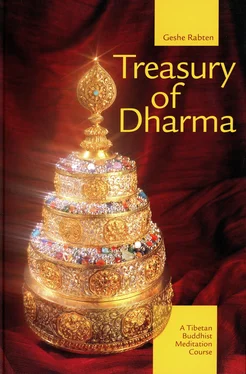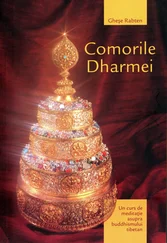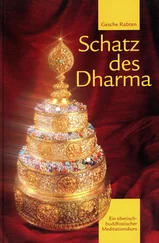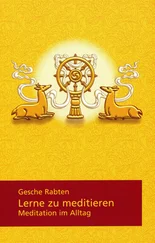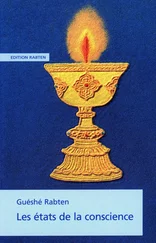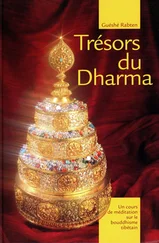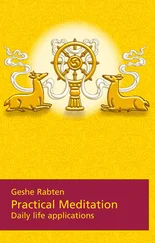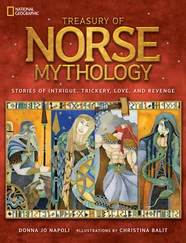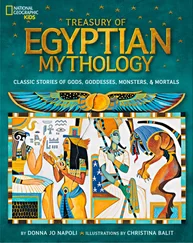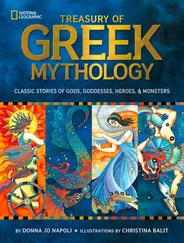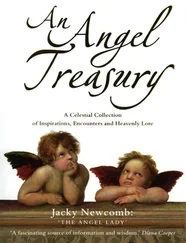Géshé Rabten - Treasury of Dharma
Здесь есть возможность читать онлайн «Géshé Rabten - Treasury of Dharma» — ознакомительный отрывок электронной книги совершенно бесплатно, а после прочтения отрывка купить полную версию. В некоторых случаях можно слушать аудио, скачать через торрент в формате fb2 и присутствует краткое содержание. Жанр: unrecognised, на английском языке. Описание произведения, (предисловие) а так же отзывы посетителей доступны на портале библиотеки ЛибКат.
- Название:Treasury of Dharma
- Автор:
- Жанр:
- Год:неизвестен
- ISBN:нет данных
- Рейтинг книги:3 / 5. Голосов: 1
-
Избранное:Добавить в избранное
- Отзывы:
-
Ваша оценка:
- 60
- 1
- 2
- 3
- 4
- 5
Treasury of Dharma: краткое содержание, описание и аннотация
Предлагаем к чтению аннотацию, описание, краткое содержание или предисловие (зависит от того, что написал сам автор книги «Treasury of Dharma»). Если вы не нашли необходимую информацию о книге — напишите в комментариях, мы постараемся отыскать её.
Treasury of Dharma — читать онлайн ознакомительный отрывок
Ниже представлен текст книги, разбитый по страницам. Система сохранения места последней прочитанной страницы, позволяет с удобством читать онлайн бесплатно книгу «Treasury of Dharma», без необходимости каждый раз заново искать на чём Вы остановились. Поставьте закладку, и сможете в любой момент перейти на страницу, на которой закончили чтение.
Интервал:
Закладка:
Geshe Rabten
Treasury of Dharma
Edited by Brian Grabia based on an oral translation by Venerable Gonsar Rinpoche
First published in 1988
Tharpa Publications, ISBN 0-948006-04-8
Photographs by Ruedi Hofstetter;
Photograph author by Gonsar Rinpoche
Illustrations: Gonsar Rinpoche p. 107;
© Tibetan Monastic Institute Rikon p. 117; Patrick Vent p. 31
© Edition Rabten
e-mail: info@editionrabten.com
http://www.rabten.eu/xvCatalog_en.htm
ISBN 3-905497-10-7
eBook: ISBN 978-2-88925-089-9
eBook Herstellung: Edition Rabten
www.rabten.eu
HEROLD Auslieferungs Service GmbH
www.herold-va.de
Preface
A treasury is a house or a container filled with various kinds of precious materials. It is not just filled with a few jewels, but is abundantly full of precious stones, precious metals and the like which the owner can wishfully enjoy.
Similarly, this book contains all the essential points of the practice of Dharma teachings of Buddha, which makes it more precious than a collection of hundreds of thousands of material jewels.
Although a person may possess a head size diamond and be skilful in using it, it cannot provide more than a partial happiness through alleviating poverty and fulfilling the need for food, clothing, housing and the like. But along with this limited happiness a lot of undesirable experiences might arise due to the danger of losing the diamond and attracting thieves and gangs.
However, even just a part of the precious Dharma not only fulfills one’s temporary needs, but also accomplishes the result of everlasting happiness.
Buddha has clearly pointed out that the root or principal cause of happiness and suffering of the sentient beings is to be found in their minds, not externally. Although many sentient and insentient objects which exist externally may sometimes serve as a condition for one’s happiness or suffering, the principal cause lies in one’s virtuous and non-virtuous states of mind. If mental factors such as ignorance, egoism, greed, hatred, pride, jealousy and so on forcefully dominate one’s mental continuum, endless problems and sufferings for oneself and others will result instead of peace and happiness. Even positive external conditions turn into negative conditions for oneself. On the contrary, if satisfaction, contentment, altruism, patience, love, compassion, wisdom and so forth are strong and stable in one‘s mind, even the negative conditions are transformed into supportive factors producing endless benefits and happiness for both oneself and others.
This is not merely a belief, a theory or philosophical hypothesis, but is established through direct experience. Therefore it is very important to bring about a positive transformation in oneself by recognising the root causes of one’s own happiness and suffering. Since the faults in the mind, no matter how great they may seem, are not in the nature of the mind itself, they can be totally eradicated. It is also a reality that no matter how weak the positive qualities in the mind, with adequate methods they can be developed infinitely. Such accurate methods are the essence of the teachings of the fully Enlightened One. Buddha showed the beings the way to ultimate liberation from all sufferings and to the attainment of lasting happiness by teaching them how to develop their minds.
In general, the entire teaching of the Buddha is contained in the Tripitaka, the so-called Three Collections, still available in more than one hundred volumes known in Tibetan as Kagyur. These scriptures are highly revered and studied in the Buddhist monasteries. The teachings they contain are as profound as the ocean and as vast as space. Today therefore, many people who are limited in their mental capacities, determination, patience and time have difficulties studying and understanding these teachings, thoroughly, and even more difficulties applying them into practice correctly.
Thus it is indispensable to have instructions which show the method of gathering and practicing the entire essence of the teachings of the Buddha in the mental continuum of an individual. Such instructions should not merely be invented or interpreted at convenience by some clever person. They should derive from a true master who, on one hand, possesses the wisdom which is brought about by a thorough analysis of these teachings, dispelling all fabrications and wrong views, and, on the other hand, has generated in himself a valid realization through complete integration of his own mind with the practice. Moreover, such instructions should be given out of compassion towards the sentient beings, without any hope for or interest in personal fame and gain. Such true masters are in general rare and texts written by such masters are indeed very rare. Every day new books emerge which may have the appearance of Dharma yet are devoid of the essence of Dharma, containing only idle gossip to entice credulous beings. To publish precious instructions like these in the form of a book at such a time is without any doubt a work of limitless benefit.
The author of this book was our compassionate master, the Venerable Geshe Rabten Rinpoche who was an outstanding scholar Pandit as well as a highly realised Siddha. He was an embodiment of compassion and an unsurpass-able refuge for this and future lives for countless sentient beings including myself.
He was born in Dargye, eastern Tibet, in 1921. Until the age of nineteen he fulfilled his family duties and then, out of his own will, chose the renounced life of a monk. Then he entered Tibet’s most reputed monastic university, Sera Tekchenling, and began his studies in the Je college. Under the guidance of his teachers such as the most Venerable Geshe Jampa Khedrup, he mastered through learning, contemplation and meditation the entire teachings of Dharma, collected in the three vehicles and the four classes of Tantra. He was renowned as a zealous student, unchallengable debater, pious practitioner and unsurpassable teacher in and out of the monastery.
Through integrating all of his intellectual knowledge with the practice of meditation, he attained the deep insight into the nature of the phenomena and the ability to fulfill the purpose of oneself and others. Due to these qualities countless seekers of Dharma have become his disciples in Tibet, in exile in India and later in the west. From these disciples outstanding masters with great qualities have come forth. Among those who are known in the west are Lama Thubten Yeshe, Lama Zopa Rinpoche, Geshe Karyang, Geshe Tenzin Gonpo, Geshe Pemba, Geshe Thubten Trinley and Geshe Thubten Ngawang, just to name a few. There are many more in India and Tibet.
His outstanding qualities were recognized and cherished not only by his disciples, but also by the great masters of our time such as H. H. the Dalai Lama and his two eminent tutors. Kyabje Trijang Dorje Chang, the junior tutor of H. H., in particular regarded him as one of his closest spiritual sons, and Geshe Rinpoche also regarded this particular master as his principal master or spiritual father who represented the embodiment of all Buddhas.
In 1964, H. H. the Dalai Lama selected Geshe Rinpoche and the Venerable Lati Rinpoche out of hundreds of Geshes to become his new Tsenshaps, that is his philosophical assistants. In 1969, in accordance with the wish of H. H. the Dalai Lama, Geshe Rinpoche started to give teachings to the westerners in Dharamsala. In 1974, at the invitation of Mme Anne Ansermet as well as many other disciples, he came to Europe for the first time and gave teachings of Dharma in many countries, thus opening the great gate of the Dharma in this part of the world. In the following year he was again sent back to Europe by H. H. the Dalai Lama as the abbot of the Tibetan Monastic Institute in Rikon, Switzerland, in order to fulfill the spiritual needs of westernes as well as Tibetans living in Europe. Eventually, due to the growing number of people seriously interested in the thorough study and practice of Buddhism, he founded Tharpa Choeling, the Center for Higher Tibetan Studies in Mont-Pèlerin, Switzerland (which was later renamed into Rabten Choeling in memory of Geshe Rinpoche); Tashi Rabten in Feldkirch, Austria; the Tibetan Center Jangchub Choeling in Hamburg, Germany; the Phuntsok Rabten Association in Munich, Germany and Ghe Phel Ling in Milan, Italy. These monasteries and cen-ters have become centers of attraction for those, who are seeking authentic and serious studies of Dharma. That, too, is the result of his uninterrupted, tireless turning of the wheel of Dharma up to the end of his life, with the sole intention to serve the teachings of Buddha and the sentient beings. Because of these reasons it is certainly appropriate to say that Geshe Rinpoche was the chief founder of the pure and complete Buddha-Dharma in Europe.
Читать дальшеИнтервал:
Закладка:
Похожие книги на «Treasury of Dharma»
Представляем Вашему вниманию похожие книги на «Treasury of Dharma» списком для выбора. Мы отобрали схожую по названию и смыслу литературу в надежде предоставить читателям больше вариантов отыскать новые, интересные, ещё непрочитанные произведения.
Обсуждение, отзывы о книге «Treasury of Dharma» и просто собственные мнения читателей. Оставьте ваши комментарии, напишите, что Вы думаете о произведении, его смысле или главных героях. Укажите что конкретно понравилось, а что нет, и почему Вы так считаете.
